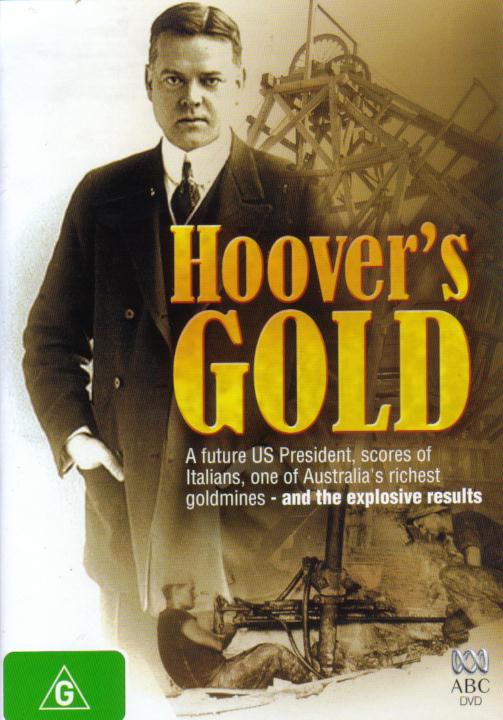Hoover's Gold (2005) |
|
Hoover's Gold (2005) |
|


|
| BUY IT |
| General | Extras | ||
| Category | Documentary |
Main Menu Audio & Animation Audio Commentary-Writer/Director Franco di Chiera & Writer Barry Strickland Additional Footage-Interviews Gallery Deleted Scenes |
|
| Rating |

|
||
| Year Of Production | 2005 | ||
| Running Time | 52:00 (Case: 82) | ||
| RSDL / Flipper | No/No | Cast & Crew | |
| Start Up | Menu | ||
| Region Coding | 2,4 | Directed By | None Given |
|
Studio
Distributor |
 Roadshow Home Entertainment |
Starring | None Given |
| Case | Amaray-Transparent | ||
| RPI | $29.95 | Music | None Given |
| Video | Audio | ||
| Pan & Scan/Full Frame | None |
English Dolby Digital 2.0 (192Kb/s) English Audio Commentary Dolby Digital 2.0 (192Kb/s) |
|
| Widescreen Aspect Ratio | 1.78:1 | ||
| 16x9 Enhancement |
 |
||
| Video Format | 576i (PAL) | ||
| Original Aspect Ratio | Unknown | Miscellaneous | |
| Jacket Pictures | No | ||
| Subtitles | English | Smoking | No |
| Annoying Product Placement | No | ||
| Action In or After Credits | No | ||
Hoover's Gold is a West Australian made documentary about an interesting footnote to the history of the State. It tells of the time, around the turn of the century, when future U.S. President Herbert Hoover came to W.A. as a key figure in the company running one of the largest goldmines in Australian history - the Sons of Gwalia.
In fact, the documentary interweaves a few stories and although the link between them is at times tenuous the documentary is interesting enough (and short enough) to entertain the viewer. The first story is about Hoover himself and his time in W.A.. The second is the lives of the immigrant workers brought to Australia by Hoover to work the mine and the third story is that of the mine itself.
It is perhaps no surprise that Hoover was destined for greatness. He was possessed, it seems, of limitless energy, not to mention an indefatigable spirit and self-confidence. He arrived in the state in 1896 and his early impressions were not flattering. He wrote in an early letter (he was a prolific letter writer):
Hoover's Gold tells these stories using a mixture of talking heads, recreations and voice-over. The voice-over is done by Vince Colosimo (apparently it is his first) in a tipped hat to the Italian connection. The interviewees include elderly residents of the goldfields, children of miners and various experts. Their stories are well told and the interviewers manage to coax some interesting tales from some of the elderly subjects. The recreations are acted only and not spoken although some accented voice-overs are used.
Telling the life of Hoover in the West does present its problems. There is no doubt that he was an efficient mine manager for his employer Bewick Moreing. His legacy, however, is more complex. He was given the task of cutting costs and raising profits. He did so by importing immigrant labour from Italy and also maintaining barely adequate safety precautions. The Bewick Moreing mines of Sons of Gwalia and Great Fingal both took their toll on workers and it is a sobering moment when we see a list of workers, many of them immigrant brothers, who died either through accidents at the mine or through lung disease from working in the harshest of environments miles under the earth.
Reputedly the best paid employee of his age in the World at the time of his second stint in the West he delivered the desired profits to Bewick Moreing. Ironically, his death was just one year before the Sons of Gwalia mine closed in 1963. It has since been reopened but is currently in administration.
Hoover is a controversial figure due to the fact that he served only one term and was largely regarded as the architect of the Great Depression. Although the legacy of Hoover in Australia is similarly murky the film does celebrate the fact that he brought an increased ethnic diversity to the state. That wasn't always appreciated. The goldfields exploded into race riots in the 1930's in the face of dwindling jobs and undercutting by the immigrant labourers.
Hoover's Gold is not a riveting or crucial documentary but it does offer some significant viewing pleasure to those interested in Australian history or the history of mining in this country.
Hoover's Gold was shot using high definition digital camera. It comes to DVD in a 1.78:1 16x9 enhanced transfer which would seem to be consistent with its original aspect ratio.
It is impeccably shot and the talking heads as well as the present day footage look clean and crisp with accurate colour and skin tones. The only treated footage is that of the recreations which are given a slight sepia hue.
There is no aliasing to speak of, even on the many corrugated iron roofs that are a feature of the Goldfields.
There are no artefacts or other defects with the image.
There are subtitles for the hearing impaired which I watched during the audio commentary. The subtitles are clear and easy to read and give a good account of the dialogue and on-screen action.
| Sharpness | |
| Shadow Detail | |
| Colour | |
| Grain/Pixelization | |
| Film-To-Video Artefacts | |
| Film Artefacts | |
| Overall |
The sound for Hoover's Gold is English Dolby Digital 2.0 (192Kb/s). This is perfectly adequate for a documentary that features mainly voice-over and interview footage. The dialogue was rendered clearly and could be heard at all times.
There are no problems with audio sync.
The music for the film is consistent with the era and includes an original musical setting of a poem (about a Kalgoorlie barmaid no less) rumoured to have been written by Hoover himself. Special mention should also be made of the Perth Italian Men's Choir who sing traditional songs and opera.
| Dialogue | |
| Audio Sync | |
| Clicks/Pops/Dropouts | |
| Surround Channel Use | |
| Subwoofer | |
| Overall |
This is a simple image of Hoover emerging from flames to the backing of Nessun Dorma
The audio commentary is by writer Barry Strickland and writer/director Franco Di Chiera. It suffers from some bad miking but this is not hard to get past. The commentary doesn't suffer from the failings of some writer commentaries as both appeared to have a close involvement with the whole film. They are earnest and proud of their work on the film and, understandably, their insights are more into the character of Hoover and the interview subjects than the film itself. A worthy listen.
This is a series of 12 deleted scenes. Mostly brief, they are still worth a look. The best is a performance by the Perth Italian Men's Choir singing a popular Italian song from the 1920's.
This is a series of 40 photographs of the goldfields during the period of the late 1800's through the race riots of the 1930's.
NOTE: To view non-R4 releases, your equipment needs to be multi-zone compatible and usually also NTSC compatible.
This film is only released in Region 4.
Hoover's Gold is an interesting documentary about a small moment in Australian history when we intersected with future greatness (or infamy, depending on how you look at it).
The transfer is excellent in both sound and vision.
The extras are suitably engaging.
| Video | |
| Audio | |
| Extras | |
| Plot | |
| Overall |
| Review Equipment | |
| DVD | Onkyo DV-SP300, using Component output |
| Display | NEC PlasmaSync 42" MP4 1024 x 768. This display device has not been calibrated. This display device is 16x9 capable. |
| Audio Decoder | Built in to amplifier/receiver. |
| Amplification | Onkyo TX-SR600 with DD-EX and DTS-ES |
| Speakers | JBL Simply Cinema SCS178 5.1 |